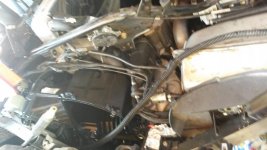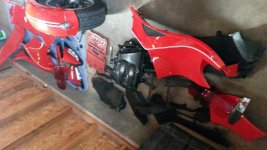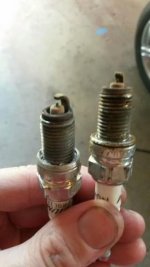I agree with Rhino79, it can be done from the LH side for both plugs.
Caveat, the smaller you arms the better.
You only have to remove the LH middle side panel, LH mirror, LH top side panel, and the plastic sheild under the top side panel.
At this point you can get to the rear plug, after changing that plug if you take a flashlight and shine it over the front cylinder you can see the plug wire for the front plug.
Before reaching in you may need to tuck some connectors that reside over the front cylinder up out of the way, this will make it easier to get your arm in.
Reaching across the front cylinder you can pull the plug wire for the front plug (hopefully grease was used so that it is not overly difficult to pull off), next using a STUBBED rachet you can then remove the plug.
From this side you also have access to the distributer and you can fish the front plug wire out for inspection (I used a 18 gauge wire fed through to fish the wire back after inspection, there is a tie rap that the plug wire goes through on the far side, but it is loose and easy (within reason) to guide the plug wire back through using the guide line wire.
Like a said, the smaller the arms the better and use of a stubbed rachet is almost needed. I didn't have one, but wish I did, the job was still not that bad and after the first one I feel that I can changed both plugs within an hour.
One other thing that will help someone who does it, is to keep in mind that when reaching across to put the plug back in the socket you need to angle it back in toward the cylinder so that you hit the hole. It took me a couple of attempts, but finally got it in.
One note on taking my front plug out, I have been noticing a miss under heavy load. When I went to remove the front plug with the rachet I was expecting to give it a reasonable wrenching for it to come loose, well it was already loose! It wasn't rattling loose, but I did not have to use any force to get it to start turning. The plugs them shelves actually looked pretty good (I had about 10,000 miles on them and they are the second set, first replaced at approx. 12,000 miles) they are whitish to grayish in color and no visible signs of blackening or improper burn.



